| Description | Participants | Summaries | Products |
|---|
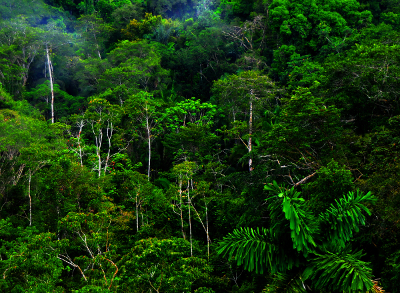
Archived NIMBioS Working Group
Climate Proxies
Topic: Translating Neotropical vegetation proxies into reliable paleo-climatic parameters
Meeting dates: Apr 20-24, 2015; Nov 3-5, 2015; Apr 4-6, 2016
Organizers:
Mark Bush, Biological Sciences, Florida Institute of Technology
Robert van Woesik, Biological Sciences, Florida Institute of Technology
Objectives: Projections of ongoing climate change suggest unparalleled rates of warming, changes in global precipitation patterns, and an order of magnitude increase in the frequency of extreme climatic events. Yet the immediacy of these projected shifts needs to be contextualized with past climatic events, including past variability and extremes. Annual to sub-decadal paleo-climatic records from the past 2000 years are available for South America. Yet we lack the needed functions to accurately translate fossil-pollen data into quantitative climatic data. This NIMBioS Working Group will take advantage of improved pollen identification, newly-available-large datasets, and rigorous geospatial analysis techniques to produce the next generation of algorithms that will translate Neotropical pollen records into reliable paleo-temperature and paleo-precipitation parameters. The biological and computational challenges that we face, including independent validation of the climatic proxies, are unlikely to be solved by any single researcher, and yet are tractable with effort that cuts across traditional disciplines. The results of the working group will be useful to a suite of academic disciplines, particularly climate modelers, biogeographers, ecologists, evolutionary biologists, archaeologists, and anthropologists.
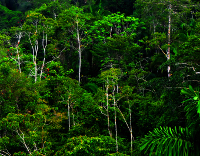
Meeting Summaries
| Mtg # | Dates | Agenda | Summary | Photo | Evaluation |
|---|---|---|---|---|---|
| 1 | Apr 20-24, 2015 | Link | Link | Report | |
| 2 | Nov 3-5, 2015 | Link | Link | ||
| 3 | Apr 4-6, 2016 | Link | Link | Final |
Meeting 1 Summary. Our goal is to construct a universal "core" model to translate fossil pollen data into statistics on past temperature and precipitation. Fossil pollen records that span the last 200,000 years provide the opportunity to assess two glacial cycles, including the last interglacial that is thought to have been warmer than today. While mean annual temperature or precipitation may be the most useful for the climatic community, the model will probably be built around more directly important biological variables, such as maximum and minimum temperature, length of dry season, interannual climatic variability, and vapor pressure deficits. If we are successful in generating transfer functions for these parameters, the mean annual statistics should be resolvable.
In this first meeting we discussed the major biological problems at hand, explored the data sources that are available to tackle these problems, and outlined the analytical means to solve them, including a preliminary derivation of the potential components of our 'core' model. It is not immediately clear which of several possible paths will be the most effective in reaching our goal, and so we will take several approaches in parallel, being mindful that we could merge these approaches in near future.
Near the end of the first week we realized that our tasks can be organized in three tiers, with the first tier focusing on the long-term goal of constructing the core model, the secondary tier focusing on components that are necessary for the core model, and the tertiary goals focusing on less essential elements of the core model that eventuated from group discussions. Paths forward and allocations of leadership on sub-projects were assigned to each of the team members. Team members unable to be present for this first meeting will be invited to join any of the emergent themes or to initiate their own line of inquiry before the second meeting, which is anticipated to be Oct-Nov 2015.
Meeting 2 Summary. The primary goal of this working group is to derive accurate pollen-based reconstructions of past atmospheric temperature and precipitation for Central and South America dating back to at least 20,000 years before present. The primary sources of information are modern climate, modern plant distributions, and fossilized pollen from lake-core records. During the second meeting, we outlined the workflow of the core-model that will hindcast past climate, cf , based on conditional information, given as cf | pf, cm, pm, where cf= climate (paleo), pf = pollen (fossilized) , cm= climate (modern), pm=pollen (fossil). We spent most of the meeting discussing analysis options and constructing the three types of input matrices pm, cm, and pf for the core models. The matrices pm and cm were generated, and are ready for core-model analysis. Pollen cores from two lakes will be used to test the models, Lake Consuelo and Lake Petén-Itzá. To test the sensitivity of our model, we will test a number of alternative data sets. For example, we will reduce the taxa in pm to include only those pollen taxa that may provide clear past-climate signals. These high-signal taxa were identified using two independent analyses that were conducted before the current meeting. We will also examine matrices using the relative abundances of pollen and presence/absence inputs, and stratify the matrices in accordance with different geographic regions. We also decided to take at least two approaches to the analysis, using (i) a traditional approach (for example using weighted average partial least squares regression) and (ii) a Bayesian approach using the same input matrices. A secondary approach was considered using hypervolume space to construct past climates. The original objectives and goals of the Working Group were discussed and refined. One manuscript has been submitted (NIMBioS was acknowledged) in October 2015, from the secondary goals. Three new spin-off projects were identified during the second meeting that will also be considered as fruitful research options.
Meeting 3 Summary. The primary goal of this Working Group is to derive accurate pollen-based reconstructions of past atmospheric temperature and precipitation for Central and South America dating back to at least 20,000 years before present. The primary sources of information are modern climate, modern plant distributions, and fossilized pollen from lake-core records. In the third meeting, in April 2016, we compiled and pre-processed the available data and began generating preliminary models using an array of approaches. These approaches include the traditional and more novel Bayesian approaches to reconstruct temperature and precipitation using two long-term paleoecological archives from Mexico and Peru. We also investigated modeling approaches that use either the relative abundance or presence and absence data of pollen. We are currently assessing the sensitivity of various inputs and the effects that certain taxa have on model outputs. We are effectively using an ensemble method to determine which datasets, model parameters, and modeling approaches provide the most ecologically and climatically realistic reconstructions. Considerable time was spent on organizing and outlining the structure of manuscripts, some of which are in press and others are in preparation. We have 11 manuscripts in progress. We are continuing to refine our original objectives and goals of the Working Group and are developing spin-off and follow-up projects that will continue even after the conclusion of this NIMBioS Working Group at the end of 2016.
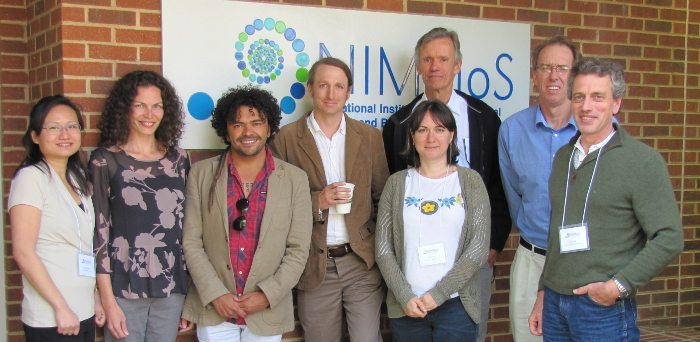 |
| Meeting 1 participants (L to R): Grace Hwang, Crystal McMichael, Alexander Correa-Metrio, Brian Enquist, Arzu Unal, Joseph Wright, Robert van Woesik, Mark Bush. Not Pictured: Miles Silman. |
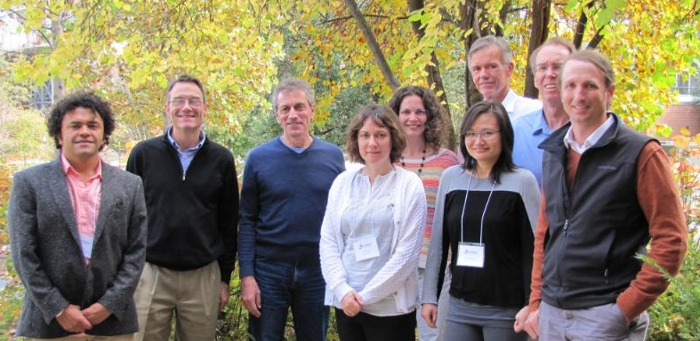 |
| Meeting 2 Participants (L to R): Alexander Correa-Metrio, Nicholas Gotelli, Mark Bush, Arzu Unal, Crystal McMichael, Grace Hwang, Joseph Wright, Robert van Woesik, Brian Enquist. |
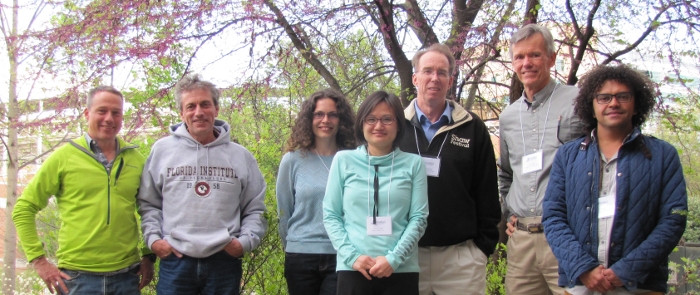 |
| Meeting 3 participants (L to R): Miles Silman, Mark Bush, Crystal McMichael, Grace Hwang, Robert van Woesik, Joseph Wright, Alexander Correa-Metrio. |
NIMBioS Working Groups are chosen to focus on major scientific questions at the interface between biology and mathematics. NIMBioS is particularly interested in questions that integrate diverse fields, require synthesis at multiple scales, and/or make use of or require development of new mathematical/computational approaches. NIMBioS Working Groups are relatively small (up to 10 participants), focus on a well-defined topic, and have well-defined goals and metrics of success. Working Groups will meet up to 3 times over a two-year period, with each meeting lasting up to 2.5 days.
A goal of NIMBioS is to enhance the cadre of researchers capable of interdisciplinary efforts across mathematics and biology. As part of this goal, NIMBioS is committed to promoting diversity in all its activities. Diversity is considered in all its aspects, social and scientific, including gender, ethnicity, scientific field, career stage, geography and type of home institution. Questions regarding diversity issues should be directed to diversity@nimbios.org. You can read more about our Diversity Plan on our NIMBioS Policies web page. The NIMBioS building is fully handicapped accessible.
NIMBioS
1122 Volunteer Blvd., Suite 106
University of Tennessee
Knoxville,
TN 37996-3410
PH: (865) 974-9334
FAX: (865) 974-9461
Contact NIMBioS


